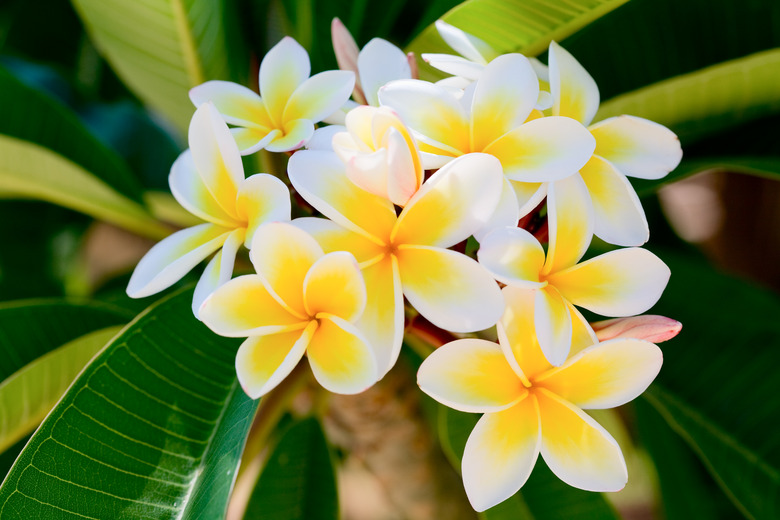The Root System Of Plumeria
We may receive a commission on purchases made from links.
Plumeria (Plumeria spp.) is known for the heavy fragrance and attractive white or pink petals of its flowers. Thanks to the relatively shallow root system of the plumeria, it can be grown in pots. While often grown in a container, a plumeria plant is actually a small flowering tree, hardy outdoors in U.S. Department of Agriculture plant hardiness zones 10 through 12. Though easy to transplant, plumeria roots do not like restriction, and special care is required to get bountiful blossoms.
Root System of Plumeria
Root System of Plumeria
Plumeria roots are fairly shallow compared to the height of the plant. The root system is small and fibrous, making it easy to transport when transplanting the plant. This type of root system means that the plant can thrive for a number of years in the same container. But if left too long, the roots can girdle and circle around the bottom of the container, leading to stunted growth once transplanted.
Transplanting is easy even when plants reach a height of 12 feet, and many growers find them easy to move as desired. But the trees are somewhat more sensitive to root disturbance when they are young.
When planting plumeria outdoors in USDA zones 10 through 12 and in south-facing sheltered microclimates in zone 9, space the trees 15 to 20 feet apart to allow room for their shallow, spreading root systems. While surface roots are generally not an issue when mowing, avoid cultivating deeply around the plumeria tree. Most tree roots are in the upper 18 to 36 inches of soil; add a layer of mulch rather than landscape plants or lawn grasses, which will compete with the plumeria for water and nutrients.
Plumeria Propagation With Cuttings
Plumeria Propagation With Cuttings
When attempting to encourage root growth in plumeria cuttings, care is required. Put on safety goggles and gloves and sterilize your cutting tools by dipping the blades in rubbing alcohol. Take cuttings of mature branches with gray bark and an active foliage tip. Remove the leaves and set the cuttings aside for several days, until the cut end stops weeping the milky sap and scabs over.
A rooting hormone helps along the process. Do not add too much water while the trees are rooting but do not allow the soil to dry out completely. Transplant your plumeria carefully as undeveloped root systems are brittle and avoid letting the plant grow in a single pot too long.
For best results, root plumerias in a humid and hot environment, and place pots on warm soil or concrete to promote root formation. Plumeria root systems need to develop quickly and unhindered to be their strongest. Use plastic nursery pots or glazed ceramic containers as plumeria roots tend to stick to clay pots.
Container Size for Plumerias
Container Size for Plumerias
Plumerias are often seen in containers, but they will suffer from reduced size and branching if the pots are not large enough. If the roots are constricted, your plumeria is likely to struggle and may not develop a thick trunk or produce significant branches or flowers. The crown of the tree will be compact in such a case.
Spring is the best time to re-pot your plumeria. Choose a 5-gallon pot as a starter then move to larger pots, such as 15 gallons. "Squat pots" are better than the standard deep garden pot; choose a container that is wider than it is tall, similar to a half-wine barrel.
General Plumeria Care
General Plumeria Care
Once your plumeria tree is established, feed it with a 10-30-10 or other high phosphorus fertilizer every one to two weeks. Water it liberally once the soil dries out and place it in a location with plenty of sunlight. Plumerias prefer their roots in shade and their crowns in the sun. Wood decks and patios are ideal locations for placement.
Avoid setting the container on hot concrete. Plumerias don't like frost either and should be protected from the cold. Re-pot your plumeria every year to avoid a root-bound plant and use a well-draining potting mix with organic matter, such as equal parts cactus mix and orchid mix, or 2 parts cactus mix combined with 1 part each of coconut coir or peat moss and compost.
Keep your plumeria plant and cuttings out of reach of children and pets. All parts of the plant are considered toxic and the milky sap can cause a rash. The alkaloids in the plant and flowers give them a very bitter taste and they can cause gastric distress if eaten.
References
- Missouri Botanical Garden: Plumeria alba
- Missouri Botanical Garden: Plumeria rubra
- University of Wisconsin-Madison Master Gardener Program: Plumeria
- UC Master Gardeners – Diggin' It in SLO: Plumeria
- The Plumeria Society of America: Plumeria Cuttings: Making and Rooting
- USDA Forest Service: Poisonous Plants – Plumeria Rubra
